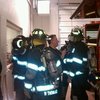Thacher Park to be four-season destination
NEW SCOTLAND —The John Boyd Thacher State Park master plan calls for a new visitors’ center, expanded hiking and biking trails, extended beach shores at Thompson’s Lake, and a new challenge ropes course.
The plan was designed by the New York State Office of Parks, Recreation and Historic Preservation, after it collected input from park stakeholders and surrounding communities in a series of public meetings over the last two years.
The plan, a first for Thacher and nearby Thompson’s Lake Park, combines them. It also calls for developing the former pool area at Thacher with a ropes challenge course and hiring a concessionaire to teach rope courses; additionally, it introduces rock climbing to the park.
Calling for the creation of a natural-heritage area, the master plan outlines new species and plant-conservation programs and redesigns several recreational areas in the park — such as the main picnic grounds and Glen Doone areas.
The plan adds a 4.6-mile bike path that will connect Thacher and Thompson’s Lake parks, and expands several hiking trails around the park.
The number of campsites at Thompson’s Lake will increase with new camping areas, smaller than the standard ones at the park now — they would be meant for tents rather than recreational vehicles. The sandy beach area along the lake will also be extended to the park’s property line, adding 1,350 square feet of beach and swimming area.
Few changes were made to the draft of the plan, presented at a hearing in New Scotland last August. Most of the 17 speakers at the hearing favored the plan overall although a couple advocated for the return of the swimming pool, closed in 2006; several who live on Thompson’s Lake objected to expanding the beach there; two equestrians asked that horses not be forbidden; and the president of a cavers’ group said some of Thacher’s several dozen caves don’t require the tours the plan calls for.
Visitors’ center
According to Park Manager Chris Fallon, construction of the new visitors’ center is a top priority under the plan.
“It’ll establish an orientation point for the park,” he said. “I think the first step is the visitors’ center and that’s our priority; with that plan in place everything will follow.”
The new center will be built at the Indian Ladder picnic area, “a few hundred feet back” from the edge of the escarpment and would be visible along Route 157, the main roadway cutting through Thacher, said Fallon.
“We’re looking to draw people in with signage,” he said. “It’ll be back a ways — we’ve considered the view from down below the cliff.”
According to the master plan, the new visitors’ center would include space for exhibits of park geology, for meetings, for park offices, and for restrooms.
A sedimentary geologist with the New York State Museum, Charles Ver Straeten was one of those who spoke during an August hearing about the plan. He cautioned officials about placing of the visitors’ center along the limestone escarpment, raising concerns about the rock’s rate of fracture. He noted the pool built at the park suffered serious problems with cracking and leakage, eventually leading to its closure.
A caver, Thomas Engel, who has visited the park for more than half a century and has mapped its structural geology, recording faults not noted before, told The Enterprise last summer that Ver Straeten’s concern was “legitimate.”
Engel described two processes at play in the park: the physical parting of the limestone, and then the dissolving or enlarging of the joints, making the ground less stable.
“The top of the cliff is limestone,” he said. “Limestone undergoes a solutional process, dissolving away slowly….The cliff is marching back westward over time.”
Engel advised then, “Make sure this stuff is being placed in the right location. The technology exists to do that.”
The Enterprise editorialized that, before the state invests taxpayers’ money in building, such tests be conducted.
After releasing the final plan, Alane Ball Chinian, the director of the Saratoga-Capital District Region Office of Parks, Recreation and Historic Preservation, responded this week, through The Enterprise, to Ver Straeten’s concerns by saying the plan’s committee had taken those concerns into consideration. She said the state would review any potential building site to ensure public safety.
“Anyone taking up the project would have to make sure the ground we’re building on is suitable,” said Fallon.
The plan calls for the facility to include a center to welcome and inform visitors; multi-functional rooms; an outdoor classroom; museum exhibits for wildlife, geology, and local history; a gift shop; a fireplace; new staff offices; and public restrooms.
Fallon said the current office building would remain a park asset. He suggested it could be used as a staging area for biking and running events or used as a meeting area for different groups such as the Friends of Thacher Park.
John Kilroy, president of the Friends of Thacher Park, said his group, which has 200 dues-paying members, is excited about the plan and the proposed visitors’ center.
“The thing looked great on a PowerPoint slide,” he said. “I hope it goes forward as they envision, with the museum and natural history areas.”
Kilroy also said the not-for-profit group is looking forward to the center having conference and meeting spaces open to the public. He also suggested a scenic area be set aside for special uses, such as weddings.
For several years, Kilroy has taken kids to rope courses at Camp Pinnacle, a Christian summer camp not far from Thacher.
“We’re very interested to see this ropes course,” said Kilroy.
Having gone through ropes courses before and shared those experiences with children, Kilroy explained the appeal: “Why do people go on a rollercoaster?” he asked, answering himself, “ It’s a thrill. You’re kind of working with a harness high above the ground; there’s an element of danger and there’s safety.”
He added, “Sliding down a zip line is a lot of fun. I’m all for getting kids outside playing. Get them away from the phones, screens and Xboxes.”
Kilroy also likes the plan’s intention to expand the sandy beach area at Thompson’s Lake, saying there were a number of occasions on warm summer weekends when the swimming area and beach were filled to capacity.
Implementation
Thacher’s master plan is a long-term planning document; officials say it will help plot the course of the park for at least the next decade.
As far as a schedule for implementation, Ball Chinian said, “It all depends on our ability to leverage help with our partners and what resources are available to us.” She added, “It’s not on a timetable; our goal is to try and make it happen within our means.”
Fallon said several of the proposals could be implemented immediately. The park is already preparing to extend the Tory Cave Trail system, he said, and is in the process of removing invasive species and clearing overgrowth from viewing areas.
The major construction project, creating the visitors’ center, Fallon said, is something he expects to develop in the next two years. An update on how the park will specifically proceed on some of the plans will be available by spring, he said.
The park is waiting to hear back from the Thacher Climbing Coalition before proceeding further with plans to allow rock climbing at the park. Fallon said the park had yet to determine where the activity would be allowed and he had no estimate on when it might be an option for visitors.
While the park is expanding trails for skiing, snowshoeing, hiking and biking, and is working to connect to local snowmobile trails, planners have decided not to allow access for horses to the park, said Fallon.
Two equestrians who currently use the park trails said, at the August hearing, they hoped horses would continue to be allowed. Marilyn Miles, who said she rides horseback in the park’s northern section, said trails for horses were “conspicuously absent” from the draft and hoped it would not be forbidden. Marietta Velvis said she wants to make sure the “multi-use trails” included equestrians. She noted there are many places in New York State where those who hike, bike, ride all-terrain vehicles, or snowmobile share the same trails.
The park will use the plan as a constant guideline, not simply a step-by-step process, said Fallon
“We’re looking at a lot of different things and several issues at the same time,” he said. “It’s not one thing verses another.”



